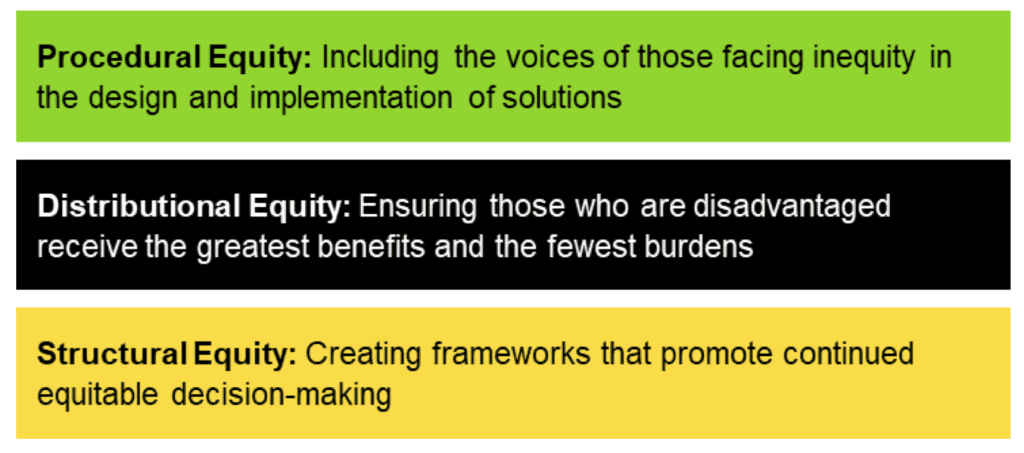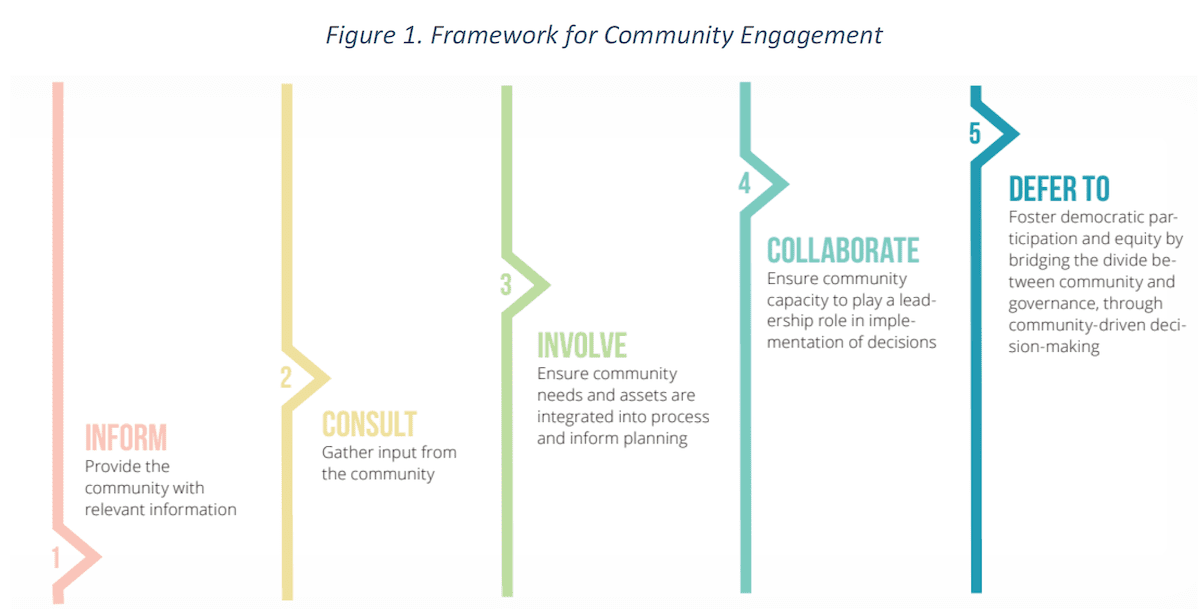A guest post from Guidehouse’s Energy, Sustainability, and Infrastructure practice, by Tori Greenen and Rodrigo Leal, with contributions by Christine Richards, Robin Maslowski, and Stuart Schare. Photo courtesy of Powertech Labs.
The COVID-19 pandemic—coupled with ongoing environmental disasters and nationwide protests against racial injustice—has put a spotlight on the disparities facing marginalized communities across the US. These crises come at a time when sustainability advocates including business leaders, government officials, and community members are grappling with the equity implications of climate action. From city climate plans to corporate environmental, social, and governance strategies, sustainability efforts are increasingly aimed at developing policies and programs that create a more equitable future.
The shift toward e-mobility presents a unique opportunity to address transportation inequities that have long plagued underinvested neighborhoods.
Readers who attended the GridFWD 2020 sessions on “How Grid Innovation Creates a More Equitable Future” heard from the panelists about how equity issues are woven into grid planning to better serve “communities that have been on the receiving end of environmental injustice.” They were cautioned not to overbuild for resiliency because the cost consequences often accrue to those least able to bear them, and they were urged to bring “empathy, education, and action” to the task. Looking forward, we can take to heart one speaker’s reflection that “there really is no good project without a community partner.”
The shift away from gas-powered vehicles toward e-mobility presents a unique opportunity to address transportation inequities that have long plagued underinvested neighborhoods. E-mobility technologies offer increased connectivity to transportation networks, provide multiple options to accommodate transportation needs and financial circumstances, and lead to cleaner air and other public health benefits. If designed with equity at the fore, e-mobility programs can transform the way communities live, work, and play.
Equitable design aims to correct current and historical racial, social, and economic injustices in three ways, as illustrated in the following figure (adopted from the Urban Sustainability Directors’ Network Equity in Sustainability report).

However, as with many trending themes or buzzwords, equity can be at risk of receiving clumsy treatment, even by well-meaning allies. For example, equity might take the form of a one-off program targeting issues that aren’t aligned with a community’s priorities or be reduced to a mere talking point. This does not have to be the case. When successfully incorporated into program design, equity can address disparities head-on, increase e-mobility program uptake and buy-in, bolster program longevity, and generate more benefits for a greater number of people.
Successfully promoting equitable outcomes in e-mobility planning requires several critical elements—foremost is that equity must be foundational to the planning process.
Equity Must Be Foundational to the Planning Process
Making equity foundational to the planning process takes forethought and proper groundwork, including defining equity within the context of the project and understanding who needs to be involved in decision-making. For example, in the initial stages of development for the Denver Electric Vehicle (EV) Action Plan, Guidehouse collaborated with the City of Denver’s Office of Social Equity & Innovation to implement an equity scoring matrix. By scoring actions, the team identified opportunities to strengthen programs and avoid unintentional harm to underserved communities, such as:
- Increasing opportunities for small and minority-owned businesses to implement workplace charging programs, as these initiatives are often focused on large corporations that already have substantial resources
- Avoiding blanket taxes or fees on vehicle registrations based on vehicle emissions that could negatively impact communities unable to purchase higher cost, low emissions vehicles
- Looking beyond single-occupancy vehicle solutions. While EV ownership may not be financially attainable for many low income communities, programs such as EV ridesharing, e-mobility hubs, and electrified community-serving vehicle fleets can provide access to the benefits of EVs for those who can’t afford to purchase one.
Decision-Makers Must Prioritize Inclusive Approaches to Outreach and Engagement
Inclusive approaches to outreach and engagement are imperative, particularlywhen engaging the underserved communities intended as the primary beneficiaries of such programs. Traditional engagement approaches are often unsuccessful because they do not aim to reduce barriers to participation, including time constraints due to work schedules, lack of transportation, childcare needs, and language obstacles. For example, online surveys are quick and inexpensive, but they often leave out those who are not tech-savvy and those without internet access or who are not proficient in English. Project managers must incorporate equitable approaches tailored to their target groups, often with the input of leaders and organizations already active in the community. Tacoma Public Utilities is overhauling its outreach efforts to promote equity by translating communications into multiple languages and working closely with community partners to reach diverse populations.
For an e-mobility project with the City of Denver, Guidehouse took a human-centered design approach to public engagement. The planning team identified community-based organizations and active community leaders whose interests and work aligned with transportation issues. The team then conducted one-on-one interviews aimed at understanding community members’ day-to-day needs and motivations, the current mobility and transportation infrastructure gaps, and the community’s mobility priorities and preferred solutions. The interviews were conducted over the phone in English and Spanish and could take place outside of traditional work hours; plus, the project compensated participants for their time.
Community Members Must Be Treated as Partners and Co-Owners of a Program
Space can be made at the decision-making table for community members through partnering with local community organizations, conducting a community-based needs assessment, or leveraging the expertise and social networks of local community leaders. More importantly, the chosen method needs to stress community agency in shaping program design and implementation. Listening to those with lived experience is a reasonable way to ensure a plan will align with a community’s unique priorities, concerns, and challenges.
The Project Team Must Ensure Community Interactions Are Thoughtful and High Impact
Finally, the project team must conduct due diligence to ensure interactions with communities are thoughtful and high impact. Community members in underserved neighborhoods often have limited time for new engagements and may receive frequent requests for input and data-gathering activities. Thus, projects should leverage existing relationships, data, and resources to avoid overburdening these communities.
In the case of Denver, Guidehouse partnered with the Department of Transportation and Infrastructure to identify synergies between separate mobility projects in the same underserved neighborhood, minimizing duplication of efforts and creating a cohesive engagement strategy that avoided overwhelming community members.
High-impact engagement is not just a technique for short-term results, it’s also embodied by the relationship between utility or government leaders and the people they serve. Deep and consistent relationships with the community, as described at GridFWD 2020 by Emeka Anyanwo, Energy Innovation and Resources Officer at Seattle City Light, are a key to achieving sustainable equity.
The need to call out equity as a central tenet of e-mobility planning stems from past failures to invest in transportation technologies, infrastructure, and services that benefit all communities. As we heard during GridFWD 2020 from Tacoma Public Utilities CEO Jackie Flowers, the city is still “in the early stages of understanding equity and putting an emphasis on placing an equity lens on all policies.” The good news is that an equity lens is beginning to take hold across utility and municipal planning processes. Moving forward, sincere but under-informed efforts won’t be enough; equity best practices must be adopted to ensure our equity-centered EV and e-mobility efforts actually create the equitable outcomes that we desire and that our communities deserve.
Authors: Tori Greenen and Rodrigo Leal work in Guidehouse’s Energy, Sustainability, and Infrastructure practice.




